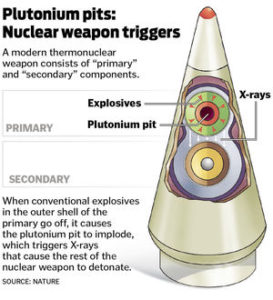
Attorneys for SRS Watch, Nuclear Watch New Mexico and Tri-Valley CAREs, plaintiffs in a federal court case demanding a “programmatic Environmental Impact Statement” (PEIS) on plutonium pit production, have mounted a strong challenge to weak Department of Justice claims that key documents should be excluded from the case.
DOE’s National Nuclear Security Administration (NNSA), the nuclear weapons arm of DOE, stores 20,000 pits at the Pantex site in Texas yet claims it needs new plutonium pit for new nuclear warheads. Pits have been shown to have a lifetime of 100 years or more, a fact that NNSA has not attempted to publicly refute. (For Pit Lifetime report, see JASON study, 2007: https://irp.fas.org/agency/dod/jason/pit.pdf)
A October 17, 2023 filing by the South Carolina Environmental Law Project (SCELP) in federal court in Columbia, SC presented convincing arguments why Department of Justice (DOJ) lawyers, acting for NNSA, is totally incorrect in its efforts to block documents being placed in the “administrative record” (AR) and that the court should allow the AR to be augmented above what DOJ entered into the record. (See SCELP filing here: SCELP filing AR record October 17 2023)
Plaintiffs argue that key documents about nuclear weapons and plutonium-related issues should have been considered in NNSA’s preparation of environmental analyses of the impacts of pit production. Amazingly, DOJ admitted in its filing of October 2023 that the documents, well known to NNSA and anyone tracking the plutonium pit issue, were not considered. (See DOJ filing here: response to motion to complete Oct 10 2023)
SCELP had filed a lengthy argument about the administrative record on and reiterated the general thrust of its case – that NNSA overlooked documents with information on environmental impacts at all sites involved in pit production or in the disposal of nuclear waste from pit production. (See SCELP filing of September 25, 2023: SCELP motion re AR Sept 25 2023 – see documents filed with motion in Docket 1:21-cv-1942)
The next step in the case, according to a September 11, 2023 schedule issued by the court, is for SCELP to file a “summary judgement” by Januray 23, 2024, in which a case will be made as to why the judge should order a PEIS to be prepared. A main argument by the plaintiffs for the PEIS is that NNSA did not consider the massive amount of plutonium waste (transuranic waste, TRU) that would be dumped in the Waste Isolation Pilot Plant (WIPP) near Carlsbad, New Mexico. NNSA’s failure to prepare the PEIS when the pit project was announced in May 2018 was a blunder that the court can correct. (See Sept. 11 docket schedule here: amended court order with new schedule Sept. 11, 2023)
In February 2023, SCELP won a ruling from the judge that plaintiffs have “standing” in the case, thus continuing the case first filed in June 2021. See SCELP news release of February 13, 2023: https://www.scelp.org/news/district-court-denies-department-of-energys-motion-to-dismiss-plutonium-pits-suit
Ask DOJ or NNSA for their other filings or find them via the PACER court document system.
Credit to “Nature” for graphic of nuclear warhead, showing plutonium “pit.” NNSA wants to manufacture 50 pits per year at SRS and 30 pits per year at Los Alamos National Lab, without proper environmental analysis of all impacts of production and waste disposal.